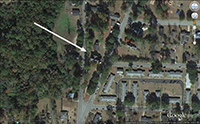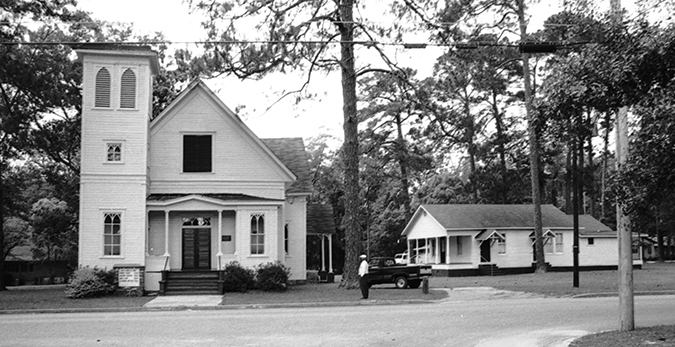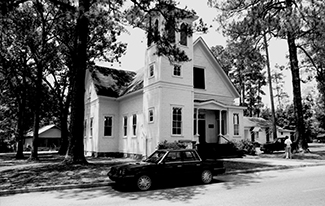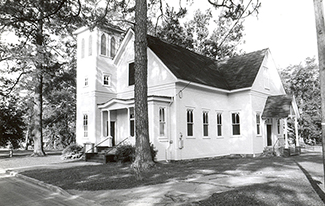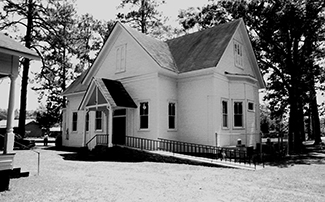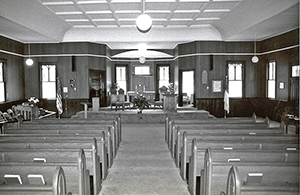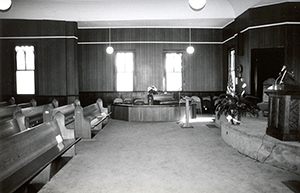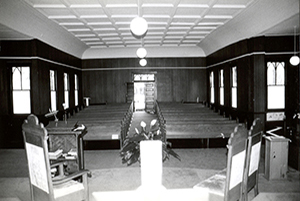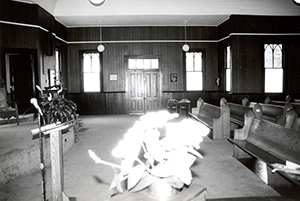Bethany Congregational Church was originally constructed in 1891 by the American Missionary Society, the missionary arm of the United Church of Christ, to serve the students at Allen Normal and Industrial School (1885-1933). The Allen School and Bethany Church were part of a series of schools and churches that were founded for African Americans in Georgia by Northern churches and philanthropists in the late nineteenth century. The original 1891 building was substantially enlarged, probably between 1915 and 1920 when the bell tower was also added. Although the school closed during the Depression and most of the structures associated with it have been demolished, the church has remained a landmark in Thomasville and was listed in the National Register of Historic Places in 1986.
|
Figure 1. East (front) façade andfrom intersection of Lester Street and Lowery Avenue. (Photograph by author) |
|---|
Bethany Church is significant, in part, for its architecture, which the National Register nomination notes “documents a type of church architecture typically associated with small black congregations in the state during the late 19th and early 20th centuries. Its wood-framed construction, central entrance, and corner tower are typical of such churches.” In fact, those features are typical of many churches, both black and white, of certain denominations. The Baptists, in particular, were the largest denomination in both races but, until well into the 20th century, their small churches seldom assumed any of the pretensions to architectural style that can be found in small Presbyterian, Methodist and Episcopal churches of the period.
In addition, the cross plan of Bethany church sets it apart from the majority of contemporary Protestant churches, regardless of denomination. Far more typical was a simple, rectangular plan with end gables or, rarely, a hipped roof. The main entrance was usually at one end and seating was oriented in the opposite direction. Very occasionally, the main entrance was in the center of one of the long sides, with seating oriented to the opposite wall. That the builders of Bethany chose a cross plan instead of the more usual, and cheaper, rectangle is another sign of the relative sophistication and affluence of the congregation, or at least of its benefactors. It is likely that Bethany had excellent financial support initially and was not limited by the scarce financial resources that often plagued African-American churches, especially the Baptist churches outside the big cities.
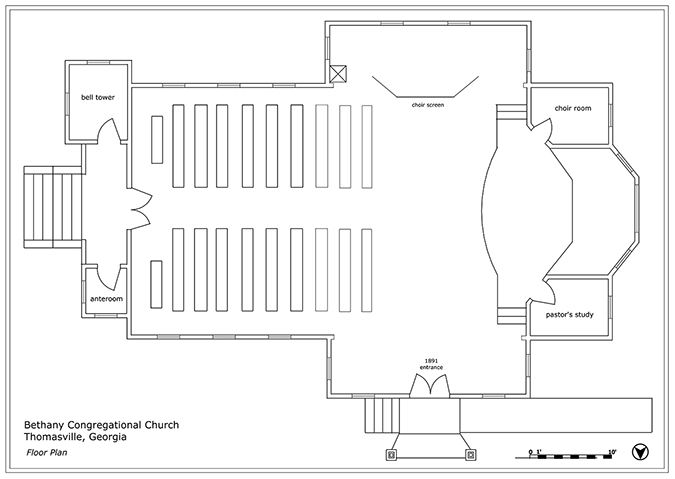
Figure 2. Floor plan of the existing building. (Drawing by author) |
Building Evolution
Located approximately one mile southwest of downtown Thomasville, Bethany Church faces in an easterly direction on a triangular lot formed by the intersection of Fletcher and Lester Streets that slopes gently from the northeast to the southwest. The present building is the result of enlargement of an original 1891 church building, which was oriented to the north, about 1915. Differences in structural and finish materials used in 1891 and those used in 1915 help establish the sequence of changes.
The National Register nomination indicates that the original church was the crossing (north-south) arms of the present building. Perhaps it was just a simple rectangular, gable-ended building with the existing north-facing entrance and porch at one end. That north entrance porch and gable have been traditionally dated to 1891 and that is probably accurate. The four-panel, double doors at that entrance are typical of the 1890s and part of a late-Victorian-era keyhole escutcheon remains on one door. The rest of the doors in the building, including those at the 1915 main entrance on the east, are six-panel and have Colonial Revival hardware, both typical of the period around World War I.
Differences in the materials and method of framing the roof, however, indicate that the original building may have been built in a Greek-cross plan (i.e., with equal length arms to the cross) and that the 1915 building simply included an extension of the east arm and construction of the present entrance porch and bell tower to the church. Certainly, the trusses over the eastern arm are larger and better built than those over the crossing and the other arms but there is no such clear distinction between parts of the framing of the remainder of the roof.
Contradicting the evidence in the attic is the apparent ghost of a door opening that is visible at the juncture of the west wall of the south arm of the present building. If that is in fact an old back door opening, then the 1891 church must have been T-shaped in plan and the 1915 renovation included not only extension of the eastern arm of the cross plan but the addition of a southern arm as well.
While it is difficult to give definitive answers to all questions about the building’s evolution, it is significant that the existing building is the result of at least two major building campaigns: the first in 1891 when the original building was constructed and the second around 1915 when that building was enlarged and embellished into the building that stands today.
Few changes were made to the building after World War I. The 1920 and 1927 Sanborn maps indicate that it still had a wood-shingled roof and was heated by a stove. The building also had electric lights, although these may have been nothing more than bare bulbs suspended from the ceiling at two or three locations in the main coved ceiling. The building may even have had a bathroom in the room under the bell tower by that time.
The closure of Allen School in 1933 must have been a serious blow to Bethany Church in terms of both membership and financial support. It could have only exacerbated the problems of building maintenance that many churches and most homeowners faced during the Depression. Much of the existing damage to the building may have occurred in the 1930s and 1940s when the congregation may have been at a very low ebb.
About 1970, some renovation of the building began. Sheet paneling was installed over the plaster walls of the building and, in 1977, the original pews were replaced and the sanctuary carpeted. In the early 1980s, another round of renovations occurred. An additional bath was added in the anteroom off the front porch. The metal roof of the building was replaced by the existing asphalt shingle roof over new plywood decking. About the same time, electrical service to the building was upgraded, but not the branch circuits within the building and the building’s gas space heaters were replaced by a central heating and air-conditioning system. The building was completely repainted on the exterior in 1996.
|
Figure 3. East and south sides of church. (Photograph by author) |
Figure 4. East and north sides of church. (Photograph by author) |
|---|---|
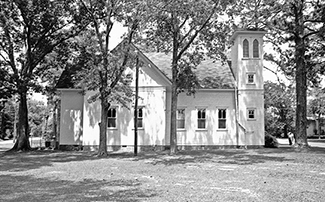
Figure 5. South side of church. (Photograph by author) |
Figure 6. North and west sides of church. (Photograph by author) |
Building Description
Bethany Church is a balloon-framed, wooden structure, with a cross-gabled roof over a Latin-cross plan. The main part of the building, which is about 16’ high from sill to eaves, measures about 60’ east (front) to west and 46’ north to south and encompasses approximately 2100 square feet of finished floor space. In addition to this, the building has a front porch, ante-room and a three-story bell tower at the east end of the cross plan as well as a three-sided apse at the west. See floor plans below.
All of the present building appears to have been constructed with circular-sawn lumber, mostly cut to standard dimensions, and wire nails that are typical of the late nineteenth and early twentieth centuries. The building’s main sills were made up of tripled 2 x 8s set on brick piers. The piers range in height from about 7” above grade at the northeast corner, to 12-13” at the southeast corner, 17” at the northwest corner, and 22” at the southwest corner. In recent years, the building’s outer sills have been underpinned between the piers with brick, with openings into the crawlspace at the east and west ends of the building. The nature of the foundation to these piers and underpinning was not discovered.
The steep gabled roof of the building is framed with rafters that are supported by large wooden trusses that span the sanctuary below. Curiously, the ceiling joists and rafters at the east end (1915) of the attic are irregularly dimensioned, ranging from 2½” to 3” by 5” to 6”. The remainder of the rafters and joists, which probably date to 1891, are a fairly uniform 2"
x 6",
cut to the full dimension that was typical of the period.
The main roof was originally wood-shingled, if the Sanborn map is correct. This was later replaced by a metal roof that was replaced by the existing asphalt shingle roof over new plywood decking that is seen on the main cross-gabled roof. Probably at that time, the old stove pipe chimney, which had been the source of many problems on the south side of the building, was taken down to the tops of the ceiling joists and roofed over.
The gabled roof at the north porch was originally also probably wood-shingled. However, the relatively flat roof over the east entrance porch and anteroom must have had a metal roof when it was constructed about 1915. The tower roof, which from the ground appears to be flat, pitches steeply up from the cornice for about a foot where it breaks to a shallow-pitched, pyramidal roof. The tower roof, too, was probably covered with metal roofing in 1915 and much of its original continuous decking remains in place. All of these roofs are now covered with asphalt roofing.
The exterior of the building is finished with 5” ship-lap siding, an unusual material for small churches of the period. In Georgia, far more prevalent in buildings of all sorts in the nineteenth and early twentieth century was the simpler, and cheaper, lap siding. The use of ship-lap siding is an example of the use of somewhat better materials than might be expected in buildings for the typical small African-American congregation of the period. The siding, too, seems to have been more used in the North than the South and its use at Bethany may be another small reminder of the huge influence that Northern interests had on Bethany and on Thomasville in the late nineteenth and early twentieth centuries.
There is no readily apparent difference between the various runs of siding around the building. There are, however, probably three generations of siding on various parts of the building, including that from 1891, 1915, and a modern replacement of much of the siding on the wall under the south gable and on the west wall of the tower.
The boxed cornice around the building includes a large crown molding on the fascia at the roof and a tongue-and-groove board soffit that is separated by bed mould from the frieze. The 12” frieze continues around the building and through each gable and also belts the bell tower where a wooden drip cap finishes the trim. Outside corners of the building are trimmed with 1" x 4" boards laid on top of the siding (not the more-typical butt joint) and finished with 1” quarter-round molding at the corner. The wooden window, door, and vent frames throughout the building are trimmed with 1" x 4" (full dimension) and a simple bed mould and drip cap at the top.
All of the windows in the present building are similarly detailed. Except in the bell tower and in the apse at the west end where there are fixed single sash, the windows are double-hung. All have two lights in the upper sash over one in the lower sash, except on the front of the building where 4-light sash are present. It is possible that the present 2/1 windows may have originally been 2/2 windows that were altered to their present condition when the lower glass was replaced in recent years.
Nearly all of the upper sash throughout the building still retain the applied muntins that help create the Gothic character of the building, although it is not known if they were a feature of the original 1891 church or of the 1915 remodeling. These muntins, which are mounted to the sash on the exterior of the glass, are an unusual example of vernacular design adaptability and ironically pre-date the much-maligned snap-on window muntins that are so popular in these days of insulated glass windows.
The oldest of the windows appear to be the two windows on either side of the 1891 north porch. These are cut from 1¼” thick stock while the windows on the east side of the 1915 extension are cut from 1” thick stock. These two windows are also the only ones that ever had shutters, which were probably put there on the front of the building in 1891 and removed when the building was remodeled and reoriented in 1915. Closer examination of all of the windows might discover similar differences elsewhere.
The attic gable and bell tower vents are, like the windows, rectangular openings trimmed to resemble Gothic arches. Thin wood panels are simply applied to the exterior of the louvered opening to create the effect of arches. Although there is presently no Gothic detailing of the large vent in the front gable, it may have been there originally.
The configurations of the vented openings themselves are somewhat different. Double louvered openings appear in both the north and south gables and a similar triple louvered opening appears in the west gable. At all of these openings, which may date to 1891, exterior shutters with movable louvers and tilt rod (typical of the period) are nailed into the openings. The double louvered openings in the front (east) gable and at the third level of the bell tower, however, are created by large slats nailed into the frame of the opening.
There are two entrances to the building. The original 1891 entrance was through the double-door opening (5’-0" x 7’-0") under the north gable. The doors, which are original, have four vertical, molded panels and is typical of the late nineteenth century. One of these doors still retains parts of its highly-decorated late-Victorian hardware.
The original entrance porch roof and columns remain in place, although what were probably a wooden porch floor and steps were later replaced by concrete steps and column piers. In recent years, new brick and concrete steps and a handicapped ramp have been installed to this entrance.
|
Figure 7. West end of sanctuary. (Photograph by author) |
|---|
|
Figure 8. South transept. (Photograph by author) |
|
Figure 10. East end of sanctuary and main entrance. (Photograph by author) |
|
Figure 11. North transept and what was the original entrance. (Photograph by author) |
Interior
The main entrance to the building is now through a front porch and double doors under the east gable. Although these doors are the same size as the doors at the north entrance, they have six horizontal panels and parts of their original Colonial Revival hardware, both of which are typical of the period around World War I. At this entrance, too, the original wooden steps have been replaced with concrete steps between brick piers but the front porch itself still retains much of its original wood flooring.
The small anteroom to the right (north) of the front porch appears to have been a part of the 1915 construction although it may not have been finished as a bathroom until very recently. At the opposite (south) end of the porch is the entrance into the bell tower. The bathroom at the first level of the tower must date to the 1930s at least if it was not part of the 1915 remodeling. Both rooms are finished with a tongue-and-groove wainscoting and other details like that found in the main sanctuary.
Modern disappearing stairs have replaced the original ladder and scuttle-hole access to the second level of the bell tower. From that level there is access to the attic of the building and a ladder to the third level of the tower. The bell is located at the third level. It is operated by a rope that hangs through holes in the floors below so that the bell can be rung without ascending above the first floor. The small bell, which is about 18” in diameter, is marked “C. S. Bell & Co./Yoke #25/Hillsboro, O[hio].”
The interior of the church is an open Latin-cross-shaped space with two small rooms (the pastor’s study and the choir room) at the western end of the cross. Between these two rooms is a three-sided projecting bay behind a two-tiered stage for the pulpit and, until recently, the choir. Recent changes included removal of the original (1915) screen that separated the pulpit area from the choir loft and placement of the communion table in the
old choir loft location. The choir is now located in the south arm of the cross plan and the old screen, with one side covered by modern paneling, is now located there as well.
A central aisle descends a raked floor from the main (east) entrance doors toward the pulpit. The floor is framed to fall from nearly 18” from east to west where it meets what must have been the original floor level of the 1891 church building. The 3-1/4”, tongue-and-groove pine floors (which probably date to 1915) have been carpeted except underneath the pews. On either side of the center aisle is a range of pews with nine 10’-long pews and one 5’9” pew in each range. These pews replaced the original pews in 1977.
The walls are finished with wainscotting made up of 5”, double-beaded, tongue-and-groove boards and a simple bull-nose chair rail and cove moulding at the top.
There is no baseboard and the wainscotting was probably originally finished by a piece of 3/4” quarter-round at the floor. All of the trim is pine, stained and probably shellacked. Above the wainscotting, the walls were originally plastered. Although the plaster was apparently not removed, it was covered by wood sheet paneling in the 1970s. The picture rail that now encircles the space is probably the original molding, reinstalled over the panelling.
The main body of the ceiling is coved and paneled with tongue-and-groove boards similar to those on the wainscotting. The 3’ x 3’ panels run north and south at the western end, where they were probably part of the 1891 ceiling, and run east and west in the 1915 addition at the eastern end. The height of the coved ceiling ranges from about sixteen feet at the western end to about fourteen and a half feet at the eastern end of the sloping floor. The other ceilings are set at about fourteen feet and are also painted white.
Utilities
The church has all modern utilities, including electricity, gas, water and sewer. Natural gas service enters the building near the southeast corner of the south gable end. It probably now feeds only the HVAC equipment in the rear but there may still be branch pipes capped off but still in place for the old gas space heaters that were in the building until the early 1980s.
Electrical service enters near the northeast corner of the building where there is a 200 amp service panel mounted on the exterior wall. The panel, which was installed in the early 1980s along with installation of the central air-conditioning system, has a pair of 50 amp breakers serving the HVAC equipment and a single 60 amp breaker serving the wiring on the interior of the building. One of the 50 amp breakers was tripped when this survey was made, an indication of possible problems with one of the HVAC units.
The two cables feeding the HVAC equipment at the west end of the building and the cable to the interior of the building all run exposed without conduit from the exterior panel box. The cable from the panel box to the interior runs to a junction box, also mounted on the exterior of the building, where it is connected with the main feed that existed before the 1980s. Several generations of wiring are visible in the building although it is not clear if all of these are still in use. The electrical service appears to have always entered the building near the northeast corner and been fused in the anteroom off the front porch. From there, knob-and-tube wiring rises to the attic where it originally fed two or three lights in the sanctuary ceiling and probably lights in the study and choir room as well. Quite often, these old electrical systems (which were typical before the 1920s) are still found in use with later wiring added to it. It is not known how much, if any, of the armored cable and modern romex wiring in the building today is attached to the original wiring system The metal fuse box (probably later than 1915) in the anteroom off the front porch still serves the interior wiring.
The building was originally heated with coal stoves and, later, natural gas space heaters. The original stove-pipe chimney has been removed to just above the ceiling on the south side of the building but its shaft remains in place from there to the ground. In the 1980s, a central heating and air-conditioning system was installed in the building. The insulated ductwork was run under the building, some of it directly on the ground, from dual air handlers located on concrete pads behind the west end of the building. The units are by Carrier, Model # 48KL060300BE and each rated at 100,000 BTUs.
The bathroom in the first floor of the bell tower may have been installed in 1915 or it may have come later. Service is provided by galvanized iron supply lines and cast-iron waste lines. The bathroom in the anteroom was added in the 1980s and is served by PVC supply and waste lines. Water and sewer lines from both bathrooms exit the building beneath the bell tower.
![]()
